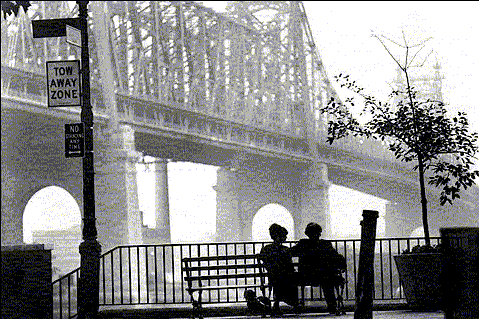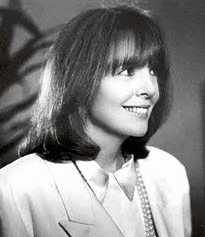 Manhattan
Manhattan
 Manhattan
Manhattan


Roger Ebert Review:
The overture is filled with brash confidence: Gershwin's "Rhapsody in Blue," played over powerful black-and-white visions of Manhattan and its skyline, and the mighty bridges leaping out to it from the provinces. The voice is filled with uncertainty and hesitation: "Chapter One. … " The voice is Woody Allen's, of course, and we find ourselves laughing—actually laughing already—on the words "Chapter One," because the Allen character is so firmly established in our imaginations that we supply the rest of the joke ourselves. "Chapter One," yes, but Woody's the definitive vulnerable artist with giant dreams, and so of course he begins with confidence but will be mired in self-doubt long, long before Chapter Two.
A great deal of the success of Allen's MANHATTAN depends on how well he has established that Woody persona. Because we believe we know him (or the character he plays), we supply additional dimensions to the situations on the screen. A movie that might seem sketchily fleshed-out in other hands becomes a great deal more resonant in Allen's: This is a variation on a familiar theme.
And the Gershwin is a masterstroke. Woody Allen populates his film with people who are at odds with their own visions of themselves. They've been so sold, indeed, on the necessity of seeming true and grave and ethical that even their affairs, their deceptions, have to be discussed in terms of "values" and "meanings"—the dialogue in this film was learned in psychoanalysis. Their rationalizations double back upon themselves, and then, clear as a bell on the sound track, there are the Gershwin songs. "S'Wonderful" and "Embraceable You" and "Sweet and Low Down" and "I've Got a Crush on You" … written as if love were simple, for chrissakes, and you actually could "fall" in love when we all know it's more a matter of pulling yourself up, hand over hand, out of a pit of snapping emotions. In Allen's earlier films, middle-class society was usually the contrast to the Woody character's hang-ups and fantasies. This time, brilliantly, he sets his entire story in a "real" world—and uses the music as the counterpoint. No wonder it's deliberately loud and dominating; Gershwin is the second most important person in this film.
Allen's humor has always been based on the contrast between his character ("Woody," spectacled, anemic, a slob, incredibly bright and verbal, tortured by self-doubt) and his goals (writing a great novel, being like Bogart, winning the love of beautiful women). The fact that he thinks he can achieve his dreams (or that he pretends he thinks he can) makes him lovable. It is amazing, for example, how many women believe they are unique because they find Woody sexy.
What Allen does in MANHATTAN is to treat both the Woody character and the goals with more realism, and to deal with them in an urban social setting we can recognize. He was already doing this in ANNIE HALL, the comedy the critics said was "really" serious—as if comedy were not already serious enough. His earlier movies were made from farce, slapstick, stand-up verbal wit, satire, and the appeal of the Woody character. ANNIE HALL and MANHATTAN are made from his observations about the way we talk and behave, and the fearsome distances between what we say and what we mean, and how we behave and how we mean to behave.
 The story follows several characters through several affairs. Woody himself is twice-divorced as the movie opens—most recently from a lesbian who is writing a book that will tell all about their marriage. He is having an affair with a seventeen-year-old girl (Mariel Hemingway). His best friend, Yale (Michael Murphy), is married and is having an affair with a girl he met at a party (Diane Keaton). But Murphy has doubts about the relationship, and so subtly tries to shift Keaton to Allen, who in the meantime thinks he wants to ditch the seventeen-year-old. Inevitably, Woody and Keaton begin to fall in love, and their courtship is photographed against magnificent Manhattan backdrops. And once this is all set up, of course, it goes topsy-turvy.
The story follows several characters through several affairs. Woody himself is twice-divorced as the movie opens—most recently from a lesbian who is writing a book that will tell all about their marriage. He is having an affair with a seventeen-year-old girl (Mariel Hemingway). His best friend, Yale (Michael Murphy), is married and is having an affair with a girl he met at a party (Diane Keaton). But Murphy has doubts about the relationship, and so subtly tries to shift Keaton to Allen, who in the meantime thinks he wants to ditch the seventeen-year-old. Inevitably, Woody and Keaton begin to fall in love, and their courtship is photographed against magnificent Manhattan backdrops. And once this is all set up, of course, it goes topsy-turvy.
The relationships aren't really the point of the movie: It's more about what people say during relationships—or, to put it more bluntly, it's about how people lie by technically telling the truth. MANHATTAN is one of the few movies that could survive a sound track of its dialogue; a lot of it, by Allen and Marshall Brickman, has the kind of convoluted intellectual cynicism of the early Nichols and May (and a lot of the rest of it consists of great one-liners).
MANHATTAN has been almost routinely praised by the New York critics as "better than ANNIE HALL." I don't think so. I think it goes wrong in the very things the New York critics like the most—when, in the last forty-five minutes or so, Allen does a subtle turn on his material and gets serious about it. I'm most disturbed by the final scene between Woody and Mariel Hemingway. It's not really thought out; Allen hasn't found the line between the irony the scene needs and the sentiment he wants his character to feel. The later scenes involving the Michael Murphy character are also not as good as the early ones; the character is seen correctly for humor, but hasn't been developed completely enough to bear the burden of confession.
And yet this is a very good movie. Woody Allen is … Woody, sublimely. Diane Keaton gives us a fresh and nicely edged New York intellectual. And Mariel Hemingway deserves some kind of special award for what's in some ways the most difficult role in the film. It wouldn't do, you see, for the love scenes between Woody and Mariel to feel awkward or to hint at cradle-snatching or an unhealthy interest on Woody's part in innocent young girls. But they don't feel that way: Hemingway's character has a certain grave intelligence, a quietly fierce pride, that, strangely enough, suggest that even at seventeen she's one Woody should be thinking of during Gershwin's "Someone to Watch Over Me."
NOTE: The video version of MANHATTAN was released with black bands at the top and bottom to preserve the wide-screen composition of the film. This unusual decision reflects Allen's perfectionism—and provides an eye-opening demonstration of how much is lost when other widescreen formats are squeezed into the video frame.
View The Classic Archive
Home